 Did you know numerous studies from top consulting firms (including McKinsey, Bain, BCG) and the Harvard Business Review have reported that 70% of corporate strategies fail? You can significantly improve your chances of success by arming your organization with the same tools used by Fortune 500 and tier-1 strategy consulting firms, such as a strategic plan template.
Did you know numerous studies from top consulting firms (including McKinsey, Bain, BCG) and the Harvard Business Review have reported that 70% of corporate strategies fail? You can significantly improve your chances of success by arming your organization with the same tools used by Fortune 500 and tier-1 strategy consulting firms, such as a strategic plan template.
In this article, we’ll walk through a specific strategic plan template based on the plans leading consulting firms such as McKinsey use. You’ll learn how to fill out each section. Or, you can just download the template immediately for free by completing the blue form on the right.
Strategic Plan Template: Key Elements
Executive Summary
The executive summary is the opening slide of the strategic plan. It provides a synthesis of the industry, competitive, and internal analyses, as well as an outline of the resultant strategic initiatives.
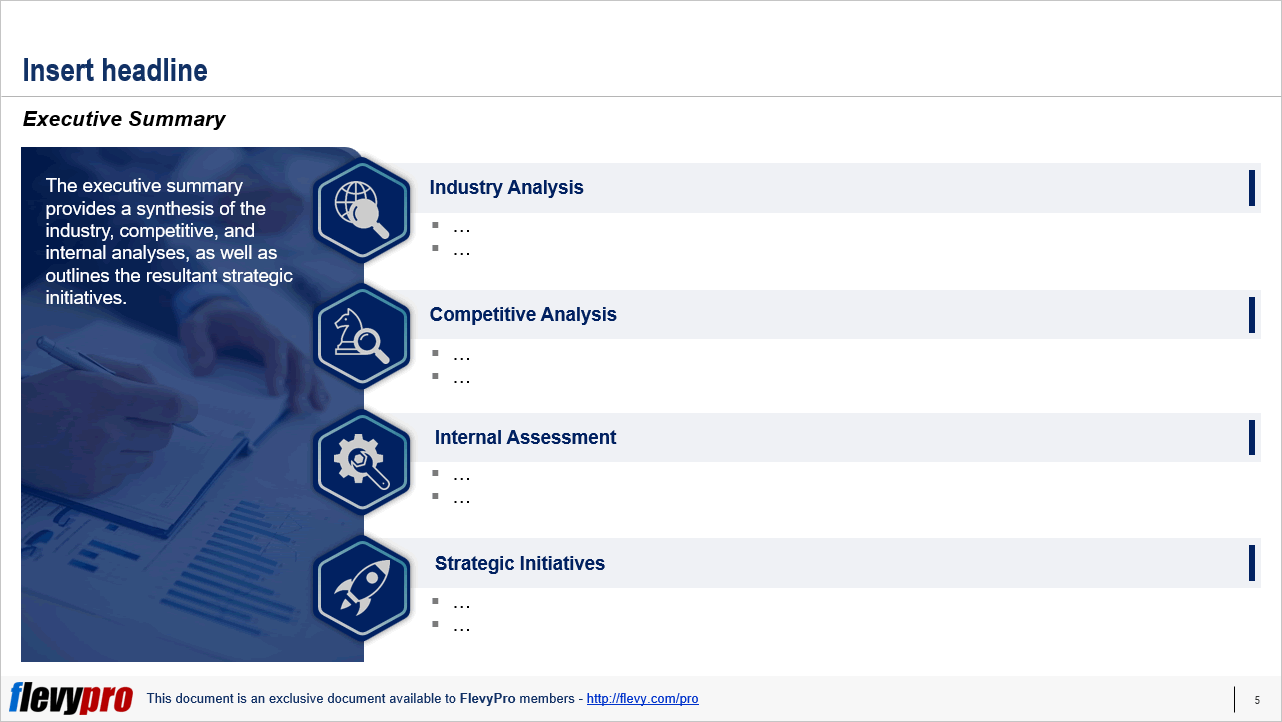
Here is an illustrative example of a completed Executive Summary slide:
Headline
Over the next 5 years, our strategy is to develop a seamless, omni-channel retail experience and launch 10 new sustainable product lines.
Overview
Our strategic vision is to deliver a seamless, omni-channel experience for customers, blending in-store retail with online and mobile experiences. Over the next 5 years, we will expand our footprint, innovate our product lines, and set new customer engagement and sustainability standards.
We see an opportunity to deliver a superior omni-channel retail experience over our competition, as our unique data-driven approach enables us to understand and predict customer behavior more accurately. By integrating advanced analytics with our customer service, we can offer personalized promotions and recommendations that set us apart.
Furthermore, we believe our customers understand that our commitment to sustainability is more than a trend. It has become an integral part of our brand identity that resonates deeply with our consumers, driving loyalty and market share.
Industry Analysis
- The retail industry is projected to experience a shift towards omni-channel strategies, with e-commerce sales growing at 10% annually.
- Consumer behavior trends indicate a preference for brands with strong ethical values and personalized shopping experiences.
Competitive Analysis
- The market is crowded with both traditional stores and e-commerce giants. Our competitive advantage is our robust supply chain and commitment to sustainability, which resonates with the values of modern consumers.
- We will capitalize on this by enhancing brand loyalty programs and community engagement.
Internal Assessment
- Internal capabilities in logistics and inventory management are strong, but there are opportunities to improve in areas such as in-store technology integration and staff training.
- Investments in these areas will ensure a seamless customer experience across all channels.
Strategic Initiatives
- Expand our online presence and mobile application features.
- Launch 10 new sustainable product lines.
- Implement AI-driven inventory management systems.
Mission, Vision, and Values
Immediately after the executive summary, we want to define our vision statement, mission statement, and core organizational values. These strategic elements are interrelated and, together, act as a guiding star, reflecting the organization's aspirations and the impact it aims to make.
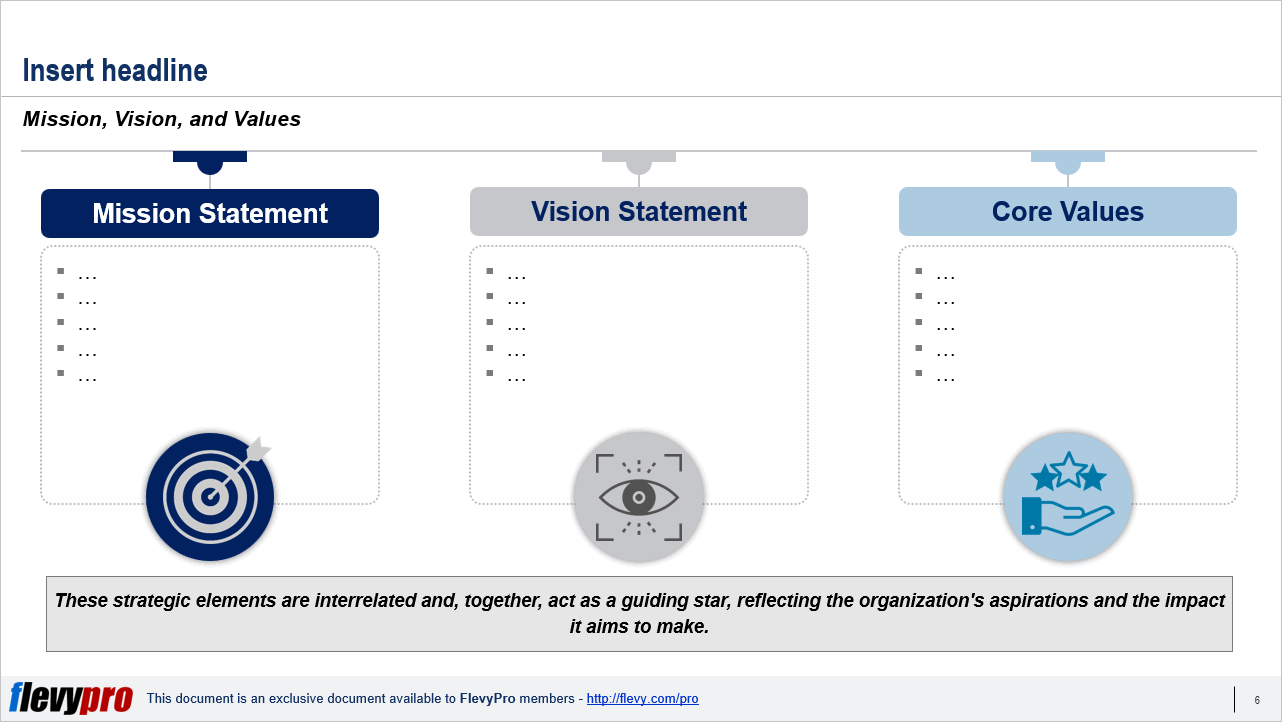
The mission statement outlines the target audience of the organization, its activities, its strategic goals, as well as its approach to reaching those goals.
The vision statement comprises 2 fundamental elements:
- Core ideology: This element articulates the organization's fundamental beliefs and the reason for its existence. It is unchanging, standing the test of time, even as markets and competitive dynamics change. Our core ideology contains the organization’s core values and core purpose.
- Envisioned future: This element represents what we aspire to become, achieve, and create. It requires significant change and progress to attain–typically envisioning a long-term objective over 10+ years.
Core values are guiding principles by which our organization operates.
To learn more about crafting mission and vision statements, refer to these resources.
Strategic Analysis
Strategic Analysis consists of 3 critical parts, each with a distinct section within our strategic plan template.
1. Industry Analysis
When analyzing the industry, the core question we seek to answer is: what are the major changes in industry dynamics and the resulting opportunities and risks?
To effectively answer this question, we should first address these 4 supporting questions:
- What industry and industry segments do we compete in?
- How is the industry structure changing?
- How do we expect competitors to react?
- What are the present and future external factors that could present new opportunities, challenges, and risks?
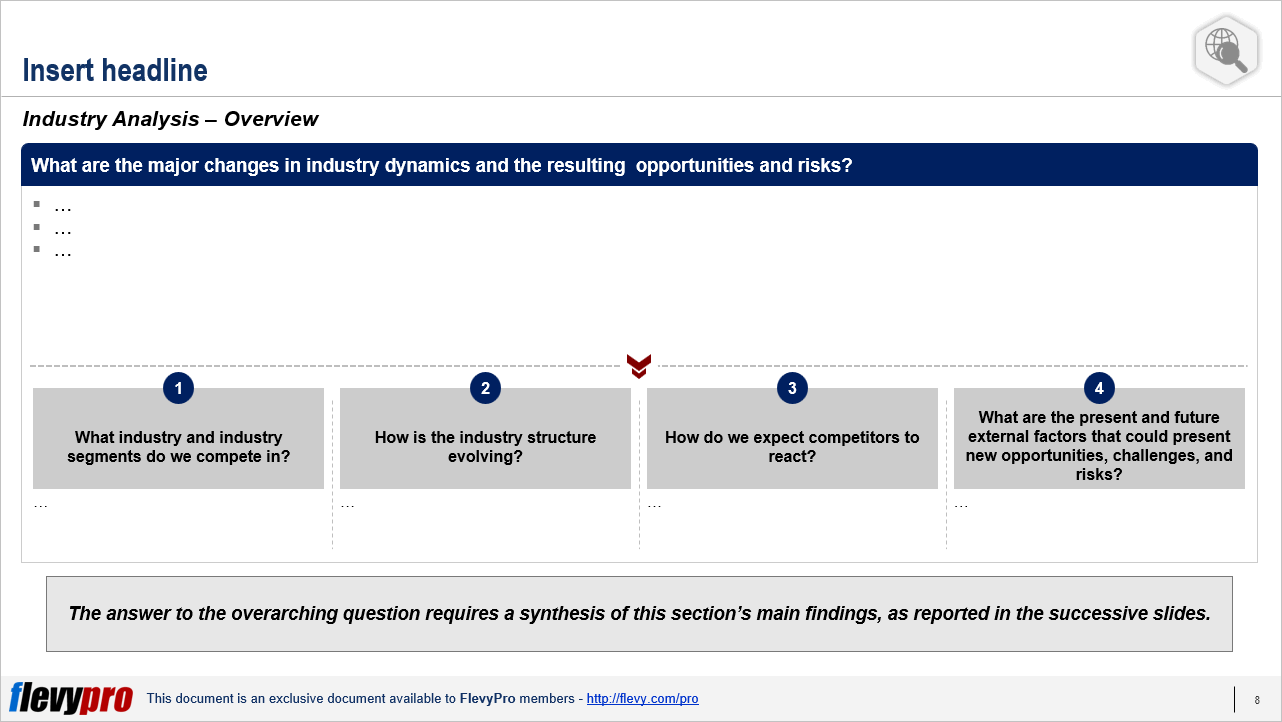
One of the most powerful frameworks for conducting Industry Analysis is the classic framework, Porter’s Five Forces. The key concept of this business framework is that there are 5 forces that drive the competitive dynamics within the industry:
- Threat of New Entrants: This force assesses how easy or difficult it is for new competitors to enter the industry. Industries that offer high returns attract more newcomers. A market that is readily accessible to new entrants presents a significant risk of eroding market share for incumbents. To mitigate this threat, the industry requires strong barriers to entry (e.g., regulatory barriers, high capital requirements, economies of scale, etc.).
- Supplier Power: The force of supplier power captures the influence suppliers have on its buyers. Suppliers with strong power can dictate prices, reduce quality, and even limit the available supply of goods available in the market. For instance, specialized semiconductor manufacturers, like Nvidia, have tremendous supplier power, being the sole supplier for many of their products.
- Buyer Power: At the other end of the spectrum, we have buyer power. A buyer with power can bring the prices down, insist on higher quality, or demand more service. As an example, Walmart has tremendous buyer power over its suppliers and essentially has the power to dictate prices from suppliers.
- Threat of Substitution: Substitute product or service offerings restrict the capacity of an industry by placing an upper limit on prices it can charge. The industry’s earnings and profits will continue to suffer unless it can enhance the quality of products or create differentiation through, for instance, aggressive marketing. Commodities typically face an extremely high threat of substitution.
- Internal Rivalry: This refers to competition among existing players. Strong rivalry can lead to competition using tactics like price competition, new product launches, and advertising wars.
For this analysis, evaluate the strength and specific threats of each force.
For example, let’s take a look at the coffee shop/cafe industry characterized by a high number of both large chains and independent cafes catering to an ever-increasing demand for specialty coffee and tea beverages. Let’s evaluate each force:
- Threat of New Entrants: The threat from new entrants is moderate, as while the initial capital investment is not exceedingly high, brand loyalty and location can serve as significant barriers.
- Supplier Power: Supplier power is moderate, given the wide availability of coffee and tea suppliers, though specialty coffee shops relying on single-origin beans may face higher supplier power.
- Buyer Power: Buyer power is high due to the abundance of choices available, allowing consumers to easily switch between different coffee shops.
- Threat of Substitution: The threat of substitution is moderate, as alternative beverage options like tea, smoothies, and energy drinks compete for consumer attention.
- Internal Rivalry: Internal rivalry is high, driven by the competition between coffee shops on factors such as price, quality, service, and atmosphere.
2. Competitive Analysis
The next section of the strategic plan focuses on Competitive Analysis. The purpose of this section is to answer the question: what are our competitive strengths and weaknesses?
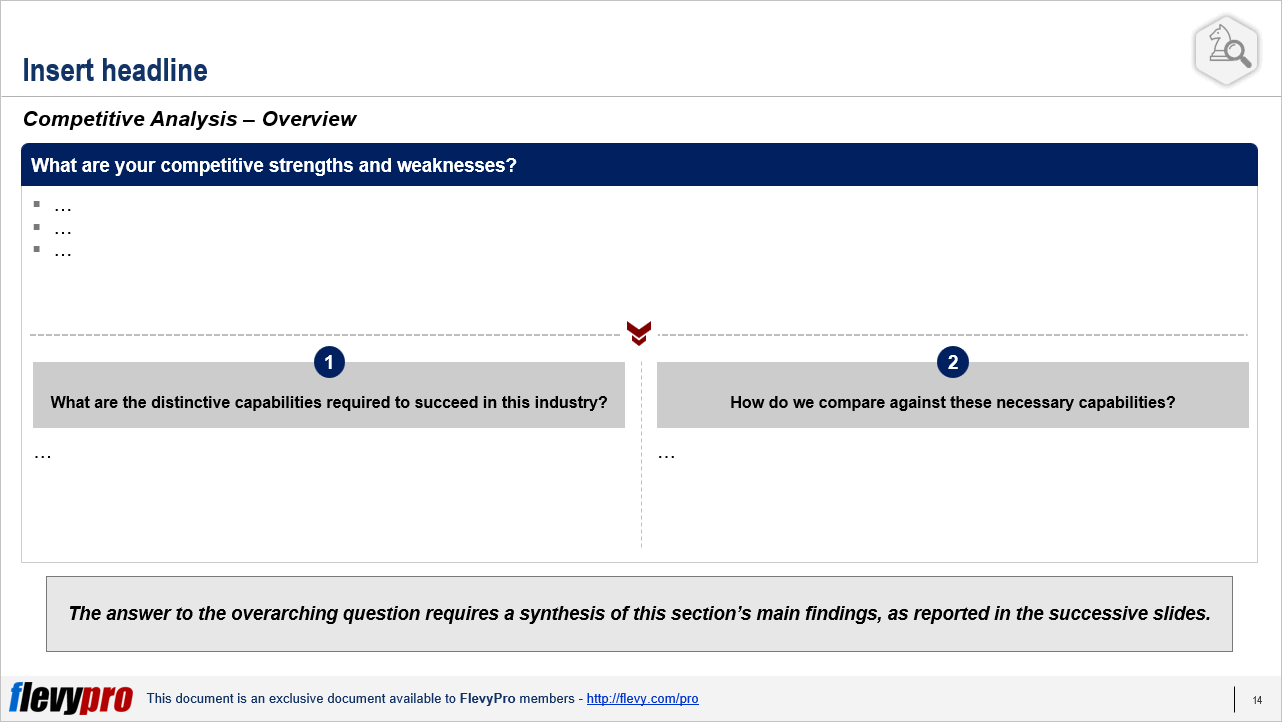
To properly conduct this assessment, we must identify and honestly evaluate the “distinctive capabilities” required by our industry. The Distinctive Capabilities Framework, developed by John Kay, defines such capabilities as ones that competition cannot easily replicate. These capabilities are otherwise referred to core competencies.
Distinctive capabilities fall under 3 categories:
- Architecture: This refers to the network of relationships an organization maintains internally with its employees and externally with customers and suppliers.
- Reputation: This encapsulates the perceptions formed through direct customer experiences, quality indicators, guarantees, word-of-mouth recommendations, warranties, and associations with other reputable brands, as well as the importance of maintaining a good reputation once it has been established.
- Innovation: Innovation serves as a critical driver for achieving a competitive advantage and can be a significant predictor of success.
Through this exercise, we must identify both the current distinctive capabilities we possess, as well as identify those capabilities that are necessary to succeed in the industry, but which we currently do not possess.
We must evaluate our competencies in each capability by benchmarking them against those of our competitors. We can conduct this assessment using a Capability Map.
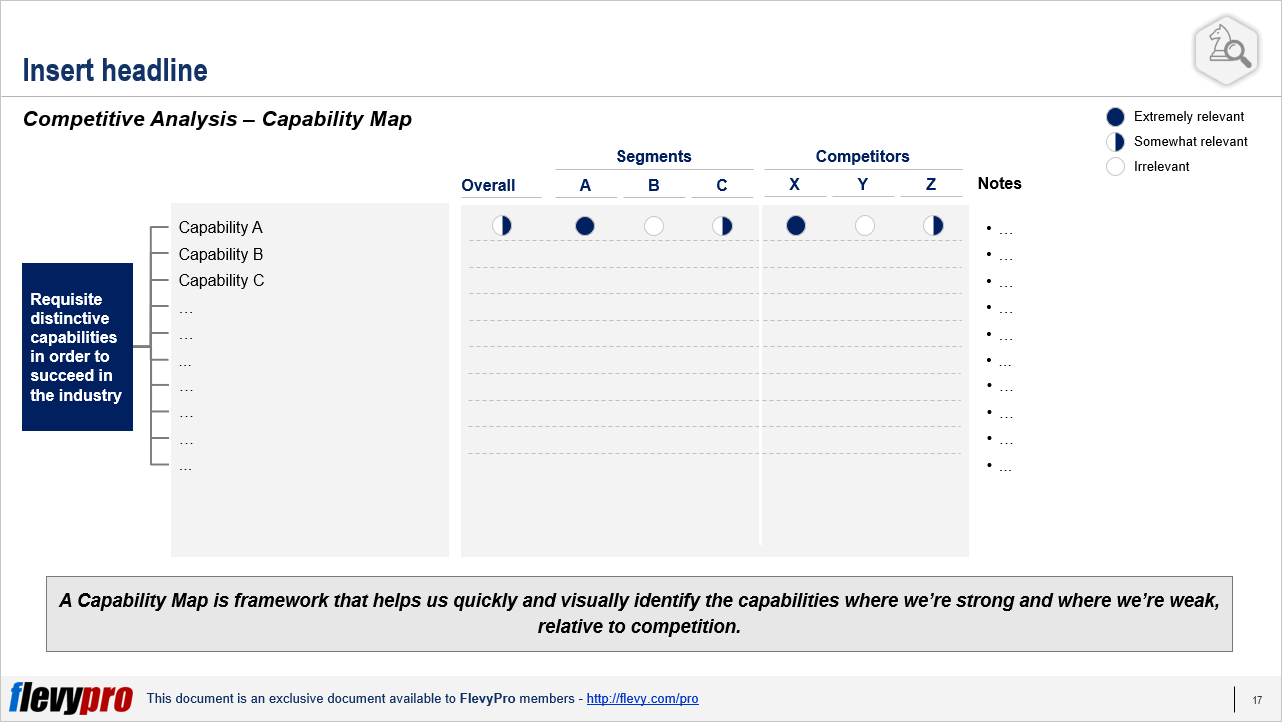
3. Internal Assessment
The previous assessments provide us with a detailed understanding of the industry opportunities and competitive landscape. We now seek to address how our current business emphasis measures up to this understanding.
To address this, we should analyze these 3 areas:
- Determine which segments of the business are providing the highest returns.
- Evaluate the performance trends along major key performance indicators (KPIs).
- Determine which intangible assets (e.g., IP, talent, brand) could be near-term potential sources of value.
Additional widely deployed frameworks that help with Environmental and Internal Assessment include: SWOT Analysis, PEST(EL)/STEEPLE Analysis, McKinsey 7-S, and Porter’s Value Chain Analysis.
Strategy Formulation
Strategy Formulation, also referred to as Strategy Development, is the most critical phase of the Strategic Planning process. In the Strategy Formulation section of the strategic plan template, our goal is to clearly articulate our strategy on paper. An organization’s business strategy can be defined across 3 time horizons, each serving a distinct purpose. You can read more about this here or take a look at McKinsey’s 3 Horizons Model.
For this section, we want to focus on the medium-term 3-5 year horizon. This is because while short-term planning focuses on immediate results and long-term planning outlines a vision for future growth, medium-term goals build the bridge between current capabilities and future aspirations. They embody the strategic initiatives that drive growth, innovation, and competitive advantage over a time frame that is actionable and measurable.
The medium-term horizon allows organizations to set realistic, achievable goals within a time frame that is long enough to develop and implement significant strategic initiatives, but short enough to remain relevant in a rapidly changing business environment.
There are 4 specific questions we seek to answer:
- What market(s) do we want to compete in? What are our strategic goals for each market segment?
- What is our Customer Value Proposition (CVP) for the different segments we plan to serve?
- What is our business model?
- How does our chosen strategy exploit industry opportunities and address threats? These opportunities and threats should have been defined in the previous section.
Strategic Initiatives
The final section of the strategic plan is the delineation of specific strategic initiatives that the organization is to pursue in the short- and medium-terms.
In the example presented earlier, we defined 3 strategic initiatives:
- Expand our online presence and mobile application features.
- Launch 10 new sustainable product lines.
- Implement AI-driven inventory management systems.
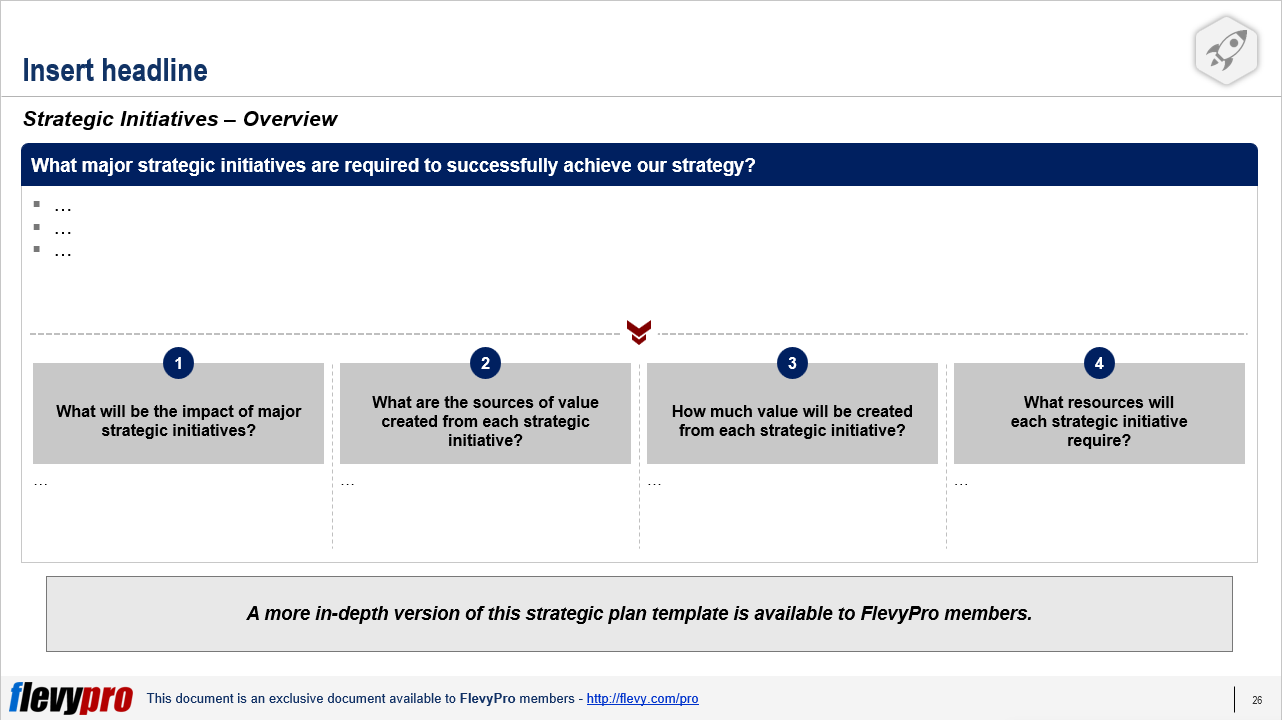
For each strategic initiative, we need to identify the strategic goals and sources of value. We can define sources of value as:
- EBIT (Earnings Before Interest and Taxes) impact driven by volume increase, price changes, cost reduction, and any other relevant changes.
- ROCE (Return on Capital Employed) impact related to investments, divestment, capital efficiency (e.g., improved working capital employment, increased asset utilization, changes to asset ownership), as well as any other relevant capital changes.
With the sources of value identified, we need to quantify the financial projections from each strategic initiative.
Lastly, it’s important to understand the resource requirements for each strategic initiative. In doing so, we should identify resource gaps and a plan to fill these gaps.
A Free Downloadable Strategic Plan Template
We have developed a free strategic plan template in PowerPoint form for you to use. To download this PPT strategic planning template, just complete the blue form on the right.
Want More Strategic Plan Templates?
At Flevy, we have a multitude of strategic plans developed by consulting firms. Here are several examples:
- Strategic Plan Template (Word)
- Business Unit Strategic Plan Template (PPT)
- Mining Industry Strategic Plan (PPT)
- Major Kitchen Supplier Growth Strategy Plan (PPT)
- Global Food Company Strategic Review Plan (PPT)
- More Strategic Plan Examples and Templates
A comprehensive, well-structured strategic plan includes both external (e.g., industry and competitive analysis) and internal analyses. There are a multitude of established business frameworks we can leverage to assist with these analyses.
Only after this analysis can we formulate a data-driven, informed strategy and determine the optimal strategic initiatives to go after. For each strategic initiative, we need to further specify the sources of value creation, quantify that value, and determine the necessary resources for implementation.
Take advantage of our free strategic plan template to facilitate this process. This template is versatile and can be used as a nonprofit strategic plan template, SMB strategic plan template, or a global corporation's strategic plan template.
You can also leverage the strategic plan to track progress during strategy implementation. To do this, you can have quarterly strategy review meetings to evaluate the current state of the strategic initiatives against the original plan. During these meetings, it’s critical to identify areas needing adjustment and make data-driven decisions to steer the strategy implementation on course. This approach turns the strategic plan into both a roadmap and a benchmark for measuring success and guiding adjustments throughout the strategy implementation process.
For more information on the full strategic planning process, have a look at this article.
FAQs
What are the 6 components of a strategic plan?
Beyond the Executive Summary, a comprehensive, well-structured strategic plan includes 6 core components:
- Mission, Vision, and Values
- Industry Analysis
- Competitive Analysis
- Internal Assessment
- Strategy Formulation
- Strategic Initiatives
Review the earlier sub-sections of this article for more information.
There are a multitude of established business frameworks we can leverage to assist with these analyses. For instance, Porter’s Five Forces is typically used for industry analysis while a SWOT analysis is often used to inform the internal assessment.
What does a strategic plan look like?
A strategic plan often takes the form of a PowerPoint presentation or Word document. PowerPoint is the preferred choice, as it is a more visual and digestible communication tool. Download our free and fully editable PowerPoint strategic plan template. Just complete the blue form to the right.
What makes a good strategic plan?
Minimally, a good strategic plan includes the following:
- Clearly defined mission statement, vision statement, and core values
- In-depth environmental and market analysis, which includes industry segmentation, industry trends, competitive comparison, distinctive capabilities
- In-depth internal assessment, which includes segment analysis, major KPIs, and sources of value
- Well-defined strategies over a 3-5 year medium-term horizon
- Well-defined strategic initiatives that outline and quantify the sources of value creation
By downloading this document, I agree to continue receiving educational materials, newsletters, product updates, event invitations, and other information from Flevy and the author. I understand I may opt out or update my preferences at any time.
Download the Strategic Plan Template now!